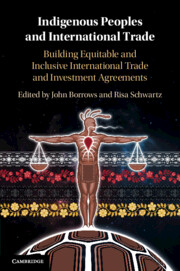 Indigenous Peoples and International Trade
Indigenous Peoples and International Trade Book contents
- Indigenous Peoples and International Trade
- Indigenous Peoples and International Trade
- Copyright page
- Contents
- Contributors
- Foreword
- Acknowledgements
- About the Cover Art
- About the Artist
- Introduction
- Part I Indigenous Peoples and International Trade and Investment
- 1 Indigenous Diversities in International Investment and Trade
- 2 Indigenous Historic Trade in the Western Hemisphere
- 3 Indigenous Peoples of Mexico at the Crossroads: The Human Cost of Continental Trade
- 4 Neocolonialism and the Tension between International Investment Law and Indigenous Peoples: The Latin American Experience
- 5 How the WTO Constructed Inuit and Indigenous Identity in EC-Seal Products
- Part II Building a More Equitable and Inclusive Free Trade Agreement
- Index
1 - Indigenous Diversities in International Investment and Trade
from Part I - Indigenous Peoples and International Trade and Investment
Published online by Cambridge University Press: 11 June 2020
- Indigenous Peoples and International Trade
- Indigenous Peoples and International Trade
- Copyright page
- Contents
- Contributors
- Foreword
- Acknowledgements
- About the Cover Art
- About the Artist
- Introduction
- Part I Indigenous Peoples and International Trade and Investment
- 1 Indigenous Diversities in International Investment and Trade
- 2 Indigenous Historic Trade in the Western Hemisphere
- 3 Indigenous Peoples of Mexico at the Crossroads: The Human Cost of Continental Trade
- 4 Neocolonialism and the Tension between International Investment Law and Indigenous Peoples: The Latin American Experience
- 5 How the WTO Constructed Inuit and Indigenous Identity in EC-Seal Products
- Part II Building a More Equitable and Inclusive Free Trade Agreement
- Index
Summary
In Chapter 1, John Borrows argues that the resurgence of Indigenous peoples’ law means that agreements are being evaluated against criteria which are not just formed by nation states or international instruments. The emergence of Indigenous normativity as an aspect of international investment and trade thus challenges communities and investors who must negotiate this new terrain. In making these points, Professor Borrows examines the role of Indigenous peoples’ law in implementing international investment and trade, including the impact of domestic law in recognizing and affirming Indigenous constitutional and statutory protections.
Keywords
- Type
- Chapter
- Information
- Indigenous Peoples and International TradeBuilding Equitable and Inclusive International Trade and Investment Agreements, pp. 11 - 42Publisher: Cambridge University PressPrint publication year: 2020
- 1
- Cited by
